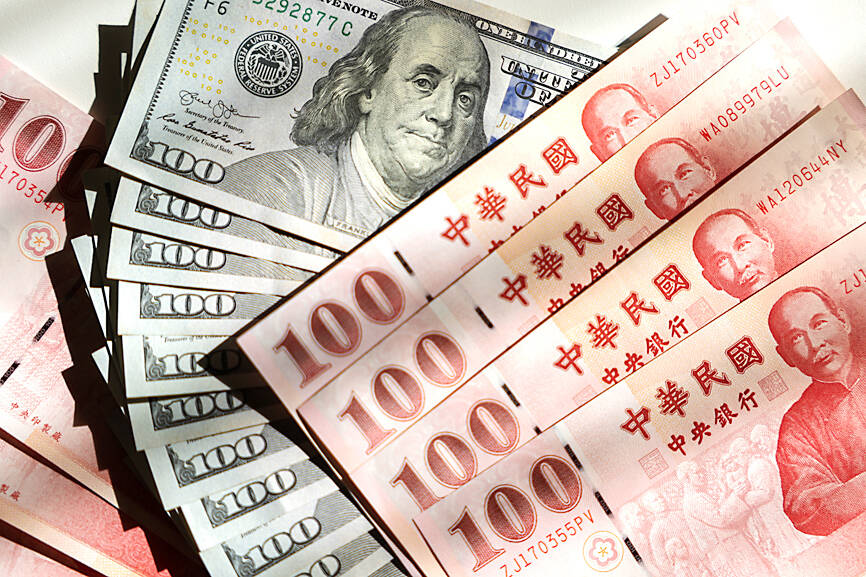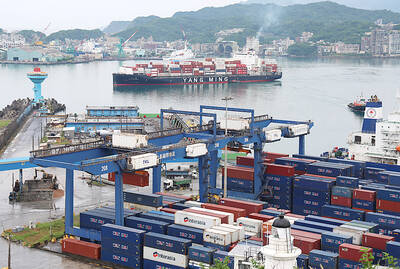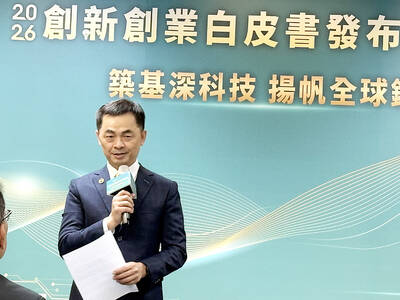Morgan Stanley has flagged a potential 10 percent revenue decline for Taiwan’s tech hardware sector this year, as a sharp appreciation of the New Taiwan dollar begins to dent the earnings power of major exporters.
In what appears to be the first such warning from a major foreign brokerage, the US investment bank said the currency’s strength — fueled by foreign capital inflows and expectations of US interest rate cuts — is compressing profit margins for manufacturers with heavy exposure to US dollar-denominated revenues.
The local currency has surged about 10 percent against the greenback over the past quarter and yesterday breached the NT$29 level, closing at NT$28.828 versus the US currency, the strongest in more than three years, central bank data showed.

Photo: CNA
The rapid appreciation poses a particular threat to Taiwan Semiconductor Manufacturing Co (TSMC, 台積電), the world’s largest contract chipmaker, with Morgan Stanley semiconductor analyst Charlie Chan (詹家鴻) estimating a 3 percentage point hit to its gross margin and a cut to TSMC’s gross margin forecast from a range of 58 to 59 percent to a range of 55 to 56 percent.
The brokerage revised downward TSMC’s earnings per share (EPS) forecast by 6 percent for this year and 12 percent for next year to NT$55.01 and NT$64.61 respectively.
Still, Chan reiterated an “overweight” rating and a target price of NT$1,288 for TSMC, citing a historical correlation between a stronger NT dollar and rising foreign ownership of TSMC shares.
The stock edged up 0.46 percent to close at NT$1,090 in Taipei trading yesterday.
“Investor sentiment may remain resilient,” Chan said, adding that despite near-term pressures, foreign investors tend to view NT dollar strength as a positive signal for valuation multiples.
Beyond TSMC, the impact would be more broadly felt across the hardware sector.
Sharon Shih (施曉娟), another Morgan Stanley analyst, warned that more than 90 percent of Taiwanese tech firms under Morgan Stanley’s coverage generate more than half of their sales in US dollars, while bearing cost structures largely in NT dollars due to domestic manufacturing bases.
Companies such as camera lens suppliers Largan Precision (大立光) and Genius Electronic Optical (玉晶光), as well as flat-penal makers Innolux (群創) and AU Optronics (友達), are among the most exposed, as rising local input costs collide with diminishing export revenues, Shih said.
While many firms adopt natural hedging strategies — matching revenue and cost currencies — the steep appreciation of the NT dollar leaves limited room to absorb shocks for companies heavily reliant on Taiwan-based production, she said.
Should the NT dollar stay in the range of NT$29 to NT$30 against the US dollar through the rest of this year, Morgan Stanley projects a 5 to 10 percent downside risk to full-year revenues for affected firms, Shih said.

CHIP RACE: Three years of overbroad export controls drove foreign competitors to pursue their own AI chips, and ‘cost US taxpayers billions of dollars,’ Nvidia said China has figured out the US strategy for allowing it to buy Nvidia Corp’s H200s and is rejecting the artificial intelligence (AI) chip in favor of domestically developed semiconductors, White House AI adviser David Sacks said, citing news reports. US President Donald Trump on Monday said that he would allow shipments of Nvidia’s H200 chips to China, part of an administration effort backed by Sacks to challenge Chinese tech champions such as Huawei Technologies Co (華為) by bringing US competition to their home market. On Friday, Sacks signaled that he was uncertain about whether that approach would work. “They’re rejecting our chips,” Sacks

Taiwan’s exports soared 56 percent year-on-year to an all-time high of US$64.05 billion last month, propelled by surging global demand for artificial intelligence (AI), high-performance computing and cloud service infrastructure, the Ministry of Finance said yesterday. Department of Statistics Director-General Beatrice Tsai (蔡美娜) called the figure an unexpected upside surprise, citing a wave of technology orders from overseas customers alongside the usual year-end shopping season for technology products. Growth is likely to remain strong this month, she said, projecting a 40 percent to 45 percent expansion on an annual basis. The outperformance could prompt the Directorate-General of Budget, Accounting and

NATIONAL SECURITY: Intel’s testing of ACM tools despite US government control ‘highlights egregious gaps in US technology protection policies,’ a former official said Chipmaker Intel Corp has tested chipmaking tools this year from a toolmaker with deep roots in China and two overseas units that were targeted by US sanctions, according to two sources with direct knowledge of the matter. Intel, which fended off calls for its CEO’s resignation from US President Donald Trump in August over his alleged ties to China, got the tools from ACM Research Inc, a Fremont, California-based producer of chipmaking equipment. Two of ACM’s units, based in Shanghai and South Korea, were among a number of firms barred last year from receiving US technology over claims they have

BARRIERS: Gudeng’s chairman said it was unlikely that the US could replicate Taiwan’s science parks in Arizona, given its strict immigration policies and cultural differences Gudeng Precision Industrial Co (家登), which supplies wafer pods to the world’s major semiconductor firms, yesterday said it is in no rush to set up production in the US due to high costs. The company supplies its customers through a warehouse in Arizona jointly operated by TSS Holdings Ltd (德鑫控股), a joint holding of Gudeng and 17 Taiwanese firms in the semiconductor supply chain, including specialty plastic compounds producer Nytex Composites Co (耐特) and automated material handling system supplier Symtek Automation Asia Co (迅得). While the company has long been exploring the feasibility of setting up production in the US to address